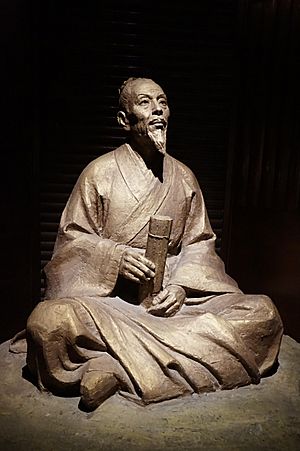Zu Chongzhi facts for kids
Quick facts for kids Zu Chongzhi |
|||||||||
|---|---|---|---|---|---|---|---|---|---|
| Traditional Chinese | 祖沖之 | ||||||||
| Simplified Chinese | 祖冲之 | ||||||||
|
|||||||||
| Wenyuan (courtesy name) | |||||||||
| Traditional Chinese | 文遠 | ||||||||
| Simplified Chinese | 文远 | ||||||||
|
|||||||||
Zu Chongzhi (Chinese: 祖沖之; 429–500 AD) was a super smart Chinese scientist. His courtesy name was Wenyuan (Chinese: 文遠). He lived a long time ago, during the Liu Song and Southern Qi dynasties.
Zu Chongzhi was many things: an astronomer, a mathematician, a politician, an inventor, and a writer. He is most famous for figuring out the value of pi with amazing accuracy. His calculation was so good that no one beat his record for over 800 years!
Contents
Zu Chongzhi's Early Life
Zu Chongzhi's family came from a place called Baoding, which is in modern-day Hebei, China. His family had to move south to the Yangtze River because of wars.
His grandfather, Zu Chang, worked for the government. He was in charge of big building projects. Zu's father, Zu Shuozhi, also worked for the court and was known for being very smart.
Zu Chongzhi was born in a city called Jiankang. His family had a history of studying the stars and planets. Because of this, Zu learned about astronomy and mathematics from a young age.
When he was just a teenager, people noticed how talented he was. The emperor of the Liu Song dynasty heard about him. He sent Zu to special academies to do research.
Amazing Discoveries in Math and Science
Zu Chongzhi made many incredible discoveries in math and astronomy. He even wrote a math book called Zhui Shu, which means "Methods for Interpolation." Sadly, this book was lost a long time ago.
How Zu Chongzhi Calculated Pi
One of Zu Chongzhi's biggest achievements was calculating pi (π). Pi is a special number used to figure out things about circles. He found that pi was somewhere between 3.1415926 and 3.1415927.
He used a very clever method to do this. He imagined a circle with a polygon (a shape with many sides) inside it. He kept adding more and more sides to the polygon, making it closer to a perfect circle. He used a polygon with an incredible 24,576 sides!
Zu also found two very good fractions for pi:
- 355113 (called milü or "close ratio")
- 227 (called yuelü or "approximate ratio")
The fraction 355113 was especially amazing. No one in Europe found this fraction until over a thousand years later! Because of this, some people call it "Zu's fraction."
Zu Chongzhi's Work in Astronomy
Zu Chongzhi was also a brilliant astronomer. He calculated time values with amazing accuracy.
Here are some of his astronomical achievements:
- He created a new calendar called the Daming calendar in 465 AD.
- He figured out the difference between a sidereal year (how long it takes Earth to orbit the sun compared to distant stars) and a tropical year (how long it takes Earth to orbit the sun compared to the seasons).
- He calculated that one year was 365.24281481 days long. This is very close to what we know today (365.24219878 days).
- He predicted eclipses four times over 23 years.
- He calculated the length of a Jupiter year, which was very close to what modern science knows.
Cool Inventions and Innovations
Zu Chongzhi wasn't just good with numbers; he also invented some cool things!
Hammer Mills
In 488 AD, Zu Chongzhi helped build water-powered hammer mills. These machines used water to power large hammers. They were probably used to grind grain or process other materials. The emperor even came to inspect them!
Paddle Boats
Zu is also given credit for inventing Chinese paddle boats in the late 5th century AD. These boats had paddle wheels that helped them move through the water. They made sailing much more reliable.
These paddle wheel ships could travel faster than other boats at the time. They could also cover long distances without needing wind.
South-Pointing Chariot
Zu Chongzhi also worked on a device called the south-pointing chariot. This was a special wheeled vehicle that always pointed south. It helped people know which direction they were going.
This chariot didn't use magnets like a modern compass. Instead, it used clever mechanical gears. It worked like the gears in a modern automobile that allow wheels to turn at different speeds. This invention had been made before by another engineer, Ma Jun, but Zu Chongzhi helped bring it back into use.
Zu Chongzhi's Legacy
Zu Chongzhi's work had a lasting impact. Many things are named after him to honor his contributions:
- His amazing pi ratio, 355113, is sometimes called Zu Chongzhi's pi ratio.
- A crater on the Moon is named Tsu Chung-Chi.
- An asteroid is named 1888 Zu Chong-Zhi.
- A modern encryption algorithm (a secret code method) is called ZUC stream cipher.
See also
 In Spanish: Zu Chongzhi para niños
In Spanish: Zu Chongzhi para niños


